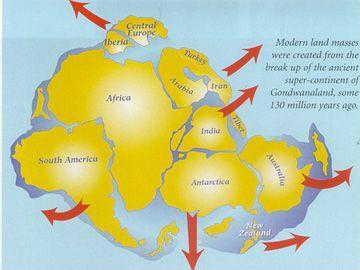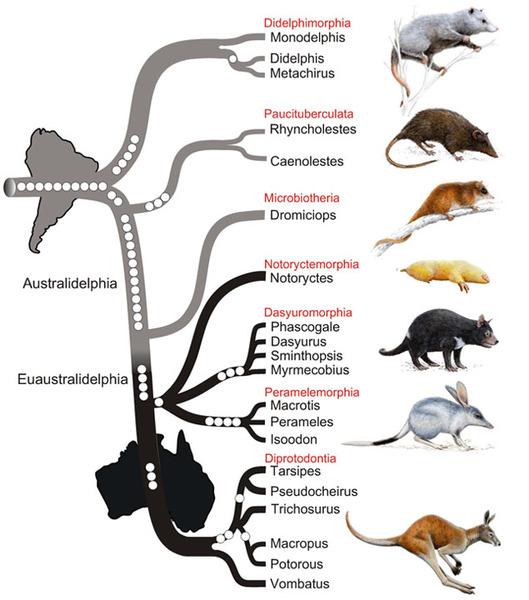Retroposons are used to confirm a single migration of marsupials from South America to Australia

While kangaroos, opossums and Tasmanian devils differ dramatically in shape and distribution, they share a common family tree. Scientists have debated for years about how these marsupials evolved and spread across the world. Now a new study dealing with "jumping" genes (retroposons ***) may answer these questions.
More than 300 species of marsupials live in the Americas and Australia. These creatures are famous for their pouch, a built-in baby-carrier, in which they guard and feed the young. Marsupials have a short gestation period and the newborns are tiny and underdeveloped. Children crawl immediately after birth into a pouch (marsupium) - which is a fold of skin attached to the bones of the pouch under the mother's abdomen, where they continue to develop for several months until their development is complete.
Marsupials are the closest relatives of the placental mammals, (which also include humans), but they split from their original group 130 million years ago. They settled mainly in South America and Australia, which at the time were part of a supercontinent called Gondwana.
Marsupials are a subdivision of the mammal department, which is divided into two groups (superseries): the Australian marsupial series and the American marsupial series. Each super series is divided into additional series, and each series - into families. For example, in the Australian super series, we find the kangaroo series, which includes the kangaroo family, possums of all kinds, koalas, pocket rats and wombats.
In trying to describe the evolution of marsupials, DNA sequencing and fossil evidence tell two different stories. The DNA suggests that a single South American ancestor drifted to Australia before the continents drifted apart, and the marsupials on each continent could have evolved separately. The fossils, on the other hand, support a more complex picture, in which some of the ancient individuals made a journey back to South America and that some South American species evolved in Australia.
This conflict stars the species Monito del Monte known as the "little mountain monkey". This is a rare and tiny marsupial that lives only in the rain forests of the southern Andes in Chile and Argentina. The little mountain monkey is active at night and nests in trees. The main component of its diet is insects and fruits. The puzzling thing is that, despite this distribution, it is classified as a close relative of an extinct species of Australian marsupial, based on a great similarity between them in the structure of the heel and the ear bones. Several researchers refer to the small mountain monkey as proof of the more complex migrations that occurred in the past. Other researchers, on the other hand, continue to advocate a single migration, this is because the DNA data is not conclusive.
To put some order in the mess, the evolutionary biologist Maria Nilsson from the University of Münster in Germany and her colleagues began to examine DNA segments called retroposons. Retroposons are broken from the chromosomal DNA, copied and pasted back in another place in the genome (that is, these are sections that "jump" from place to place in the DNA). Unlike the rest of the genetic code, which is subject to mutations and other random events that can make genetic analysis difficult, retroposons and their location are predictable and remain stable after being copied and pasted into the new location. This feature makes them more reliable markers that can be relied upon to determine evolutionary relationship and kinship between species; If two species have the same retroposons in the same locations, they probably share a common ancestor.

Nilsson compared the South American opossum, the Australian wallaby (a small marsupial similar to a kangaroo) and 20 other marsupial species, including the Australian wombat, wallaroo and more. All marsupials tested had the same 10 retroposons, a finding that confirms the fact that they all share a common ancestor. South American marsupials have undergone fewer retrophase jump events, suggesting they evolved from a later branch of the family tree. Opossums lack two retroposons that are almost universally common, a fact that may suggest they are genetically closest to the marsupial ancestor, Nilsson says. Even for the mysterious monito the mystery has been solved and its place on the family tree has been found: it shares certain genetic traits with the Australian marsupials, but is undoubtedly closer to the South American marsupials.
The retroposon data allow a clear division of the Australian and South American marsupials into distinct groups - which suggests very little connection between them during their evolutionary development.
From the totality of the data it can be concluded that a single event of migration from South America to Australia led to the variety of marsupial species known today, including the monito. And as Nelson testifies, "I was very enthusiastic. I think the research is about to resolve a controversy."
The findings, published in early August, represent a major step forward in understanding the relationships and connections between marsupial species, says evolutionary biologist Matthew Phillips of the Australian University of Canberra. The only shortcoming of the retroposon technique, according to Phillips, is that it does not take into account dead ends - marsupial species that have gone extinct and probably filled out the family tree. Since these species have become extinct, it is not currently possible to test their DNA and carry out the detection tests for retroposons, so it is not possible to determine their exact position in the family tree. Combining the retroposon technique with the fossil data can help researchers get a more detailed picture of when and how the ancestors of marsupial species migrated. "The current study" says Phillips "provides an effective technique and creates the foundations for further studies in the field."
*** Retroposons (Wikipedia in English) are replicative DNA segments inserted into chromosomes after undergoing reverse transcription from an RNA molecule. Unlike retrotransposons, retroposons do not encode the enzyme RT, reverse transcriptase, themselves. Therefore, they constitute non-autonomous elements with respect to their transposition activity (compared to transposons).
